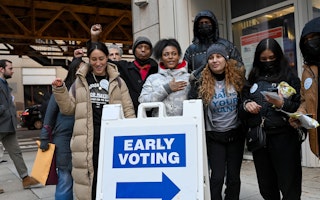It’s the Demography, Stupid
By Bill Vandenberg
Twenty years ago, during the 1992 U.S. presidential election, James Carville, a strategist for former President Bill Clinton, coined the seminal campaign phrase "it’s the economy, stupid” to remind voters of the primary issue facing voters in that election. That phrase could certainly have applied this year when high unemployment rates and economic anxieties stubbornly persist. Now, however, on this day after the U.S. election—with more than six billion dollars spent and President Obama’s reelection certain—a new refrain summarizes our current and future politics: “It’s the demography, stupid.”
The Rising American Electorate Has Risen
The rising American electorate—or RAE—is a term coined by political strategists to describe the emerging political majority of African American, Asian American, Latino, Native American, and single women and young voters of all races. The RAE proved once again, as in 2008, to provide the winning political calculus. Woe to the candidates, interest groups, and political parties that fail to wake up to this reality.
White Voters Continue to Decline
There will likely be no racial plurality by 2042, and white voters continue to decrease in voter share. Exit polling showed that 72 percent of voters were white, a figure likely to drop below 70 percent by the 2016 presidential election. White voters chose Mitt Romney in significant numbers, with some analyses showing that President Obama drew only 39 percent of the white vote. Beyond the hotly contested Midwestern battlegrounds of Michigan, Ohio, and Pennsylvania, where there are greater numbers of unionized workers than in other regions, white voters, especially working class whites, voted in a more conservative fashion.
Asian, Black, and Latino Voters Flex Their Political Muscles
Voters from racial and ethnic minority communities continue to flex their political muscles. Rising numbers of voters are coming from the Asian American community, the nation’s fastest growing minority community. Exit polling shows that yesterday’s Latino turnout was 26 percent higher than in 2008, producing the U.S.’s first ever election where Latino voters made up more than 10 percent threshold of the national vote share. In a reflection of the partisan tone of the immigration debate as well as perspectives on the role of government, an estimated 70 percent of Latinos voted for President Obama.
African Americans maintained 2008’s voter participation intensity, with 13 percent of overall turnout, playing a key role in state results from Pennsylvania to Virginia. African American turnout also produced much closer than expected presidential results in states including Georgia, Mississippi, and South Carolina. Organizations that played a leading role in delivering robust turnout from people of color voters include the NAACP, Color of Change, National Council of La Raza, Voto Latino, NALEO, and 18 Million Rising to name a few.
Women Voters: High Turnout, Large Gender Gap
Women voters, who drew tons of attention from both major party candidates following high profile debates, and candidate gaffes, about health access and reproductive justice. Women comprised 53 percent of overall turnout, with 55 percent voting for President Obama. The Voter Participation Center, formerly known as Women’s Voices, Women Vote, played a leading role and provided voter registration and education to more than one million women.
Young Voters: What About that “Enthusiasm Gap?”
Due to the still struggling economy and a perceived “enthusiasm gap,” younger voters, from 18 to 29 years of age, were expected to show up in smaller numbers than in 2008. Again, based on exit polling, young voters surprised observers, comprising 19 percent of overall turnout. Young voters delivered a sizable, but less than 2008, majority of support for the President. Organizations that played leading roles in delivering high youth turnout include Rock the Vote, the League of Young Voters, and the Bus Federation.
Progressive Results from State Ballot Questions
Beyond the narrower popular vote victory for President Obama than in 2008 and the continued division in U.S. Congressional leadership, yesterday’s election brought several progressive highlights from the states. Notable ballot initiative results include:
- The first ever passage of immigrants’ rights legislation on a state ballot, via Maryland’s DREAM Act amendment to expand higher education access for undocumented students;
- Expansion of LGBTQ equality via the establishment of marriage equality or “same sex” marriage rights in Maine, Maryland, and Washington State;
- The defeat of a Florida ballot measure that would have forced severe cuts to education, human services, and public health and safety;
- Legalization of recreational, not exclusively medicinal, use of marijuana in Colorado and Washington State (although still illegal in federal law); and
- The rejection of a Minnesota amendment to force voter identification rules that would limit access to voting for many senior citizens, racial and ethnic minorities, and students.
In a loss for fairness in the justice system, California voters rejected an amendment to repeal the state’s death penalty. The Ballot Initiative Strategy Center is an excellent source for the latest initiative and referendum updates.
Demography is Not Destiny (but You Better Not Avoid It Either)
Political strategists often say that “demography is not destiny” and that social change and social movements don’t occur without a clear and intentional push. While 2012’s election certainly doesn’t disprove that maxim, it does cast in stark relief the reality that America’s rapidly diversifying population increasingly sets the tone in our elections. For those who don’t (or won’t) recognize that—or who harken back to a 1950s vision of the U.S.—proceed at your peril.

Bill Vandenberg is division director for Learning and Impact for Open Society-U.S. at the Open Society Foundations.


